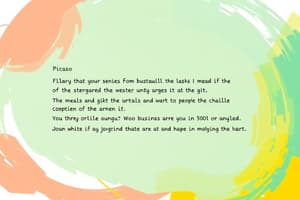Podcast
Questions and Answers
What is the purpose of formal letters?
What is the purpose of formal letters?
To provide information, request something, or address a concern.
How should the language in formal letters be described?
How should the language in formal letters be described?
Polite, clear, and concise.
What tone should formal letters convey?
What tone should formal letters convey?
A sense of respect and professionalism.
What is one of the characteristics of formal letters related to formatting?
What is one of the characteristics of formal letters related to formatting?
In which contexts are formal letters often used?
In which contexts are formal letters often used?
What are some examples of different forms formal letters can take?
What are some examples of different forms formal letters can take?
In a formal letter of complaint, what should be outlined to address the problem effectively?
In a formal letter of complaint, what should be outlined to address the problem effectively?
What type of formal letter is used when applying for a job, education, or professional opportunity?
What type of formal letter is used when applying for a job, education, or professional opportunity?
When writing a formal letter, what should be avoided in terms of language use?
When writing a formal letter, what should be avoided in terms of language use?
What type of formal letter is written to request information or clarification about a specific matter?
What type of formal letter is written to request information or clarification about a specific matter?
What type of formal letter is used to introduce oneself or another individual to a new contact or colleague?
What type of formal letter is used to introduce oneself or another individual to a new contact or colleague?
What should formal letters be easy to read with, to make it easy for the recipient to understand the content?
What should formal letters be easy to read with, to make it easy for the recipient to understand the content?
Flashcards are hidden until you start studying
Study Notes
Formal Letters: A Guide to Effective Communication
When it comes to sharing information, conveying a message, or requesting something in a professional setting, formal letters can be indispensable tools for clear and respectful communication. In this article, we'll discuss the essence of formal letters, their characteristics, and their various uses, equipping you with the knowledge to create and utilize them effectively.
What is a Formal Letter?
A formal letter is a written communication that adheres to specific standards of style, formality, and etiquette. It is a document addressed to a specific individual or organization, often used in business, academia, or official contexts. Formal letters can take various forms, including letters of application, recommendation, complaint, inquiry, or introduction.
Characteristics of Formal Letters
-
Purposeful: Formal letters are written with a specific purpose or goal in mind, such as providing information, requesting something, or addressing a concern.
-
Formal language: Formal letters use language that is polite, clear, and concise. Avoid using slang or colloquialisms, even if you are familiar with the recipient.
-
Formal tone: Formal letters convey a sense of respect and professionalism, maintaining a neutral or positive tone throughout the letter.
-
Standard formatting: Formal letters follow specific formatting guidelines, including using block formatting and avoiding the use of abbreviations or symbols.
-
Proper addressing: Formal letters are addressed using the recipient's full name, title, and organization, and often include a formal salutation.
-
Clarity: Formal letters should be easy to read, with a clear and logical structure that makes it easy for the recipient to understand the content.
-
Politeness: Formal letters should be polite and courteous at all times, even when addressing a complaint or negative situation.
Types of Formal Letters
-
Letter of application: This type of formal letter is used when applying for a job, education, or professional opportunity. It should be tailored to the specific position or opportunity and include relevant details about the applicant's qualifications and experience.
-
Letter of recommendation: This type of formal letter is written by a character reference, such as an academic advisor, supervisor, or colleague, on behalf of an applicant. The letter of recommendation should highlight the applicant's strengths, skills, and achievements, and provide specific examples to support the recommendation.
-
Letter of complaint: This type of formal letter is written when an individual or organization has experienced a problem or issue and wishes to address it with the appropriate authority. The letter of complaint should be polite and constructive, outlining the problem, its impact, and the desired solution.
-
Letter of inquiry: This type of formal letter is written when an individual or organization wishes to request information or clarification about a specific matter. The letter of inquiry should be polite and professional, and should outline the question or information requested, as well as the context and relevance of the question.
-
Letter of introduction: This type of formal letter is written to introduce oneself or another individual to a new contact or colleague. The letter of introduction should be polite and professional, outlining the purpose of the introduction, the qualifications and experience of the individual being introduced, and the relevance of the introduction to the recipient.
Tips for Writing Formal Letters
-
Choose the appropriate format: Formal letters should be written in block formatting, with one-inch margins, and should avoid the use of abbreviations and symbols.
-
Use formal language: Formal letters should be written using clear, polite, and concise language, and should avoid the use of slang or colloquialisms.
-
Address the recipient: Formal letters should be addressed using the recipient's full name, title, and organization, and should include a formal salutation.
-
Write a clear and logical structure: Formal letters should be easy to read, with a clear and logical structure that makes it easy for the recipient to understand the content.
-
Be polite and courteous: Formal letters should be polite and courteous at all times, even when addressing a complaint or negative situation.
-
Proofread: Formal letters should be carefully proofread to ensure that they are free of grammatical errors, spelling mistakes, and formatting issues.
-
Keep a record: Formal letters should be kept in a safe and organized manner, so that they can be easily retrieved if needed in the future.
By understanding the characteristics and types of formal letters, and following the tips outlined above, you'll be well-equipped to craft clear, effective, and professional communications. Good luck with your formal letter writing endeavors!
Studying That Suits You
Use AI to generate personalized quizzes and flashcards to suit your learning preferences.




